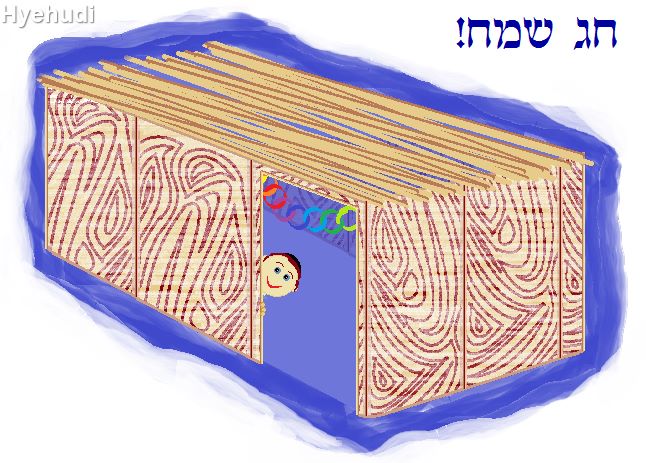Hag Sameach
Contributed by Rabbi Arthur E. Gould
You can build it very small1
You can build it very tall2
You can build it very large3
You can build it on a barge
You can build it on a ship4
Or on a roof but please don’t slip5
You can build it in an alley6
You shouldn’t build it in a valley7
You can build it on a wagon8
You can build it on a dragon9
You can make the skakh of wood10
Would you, could you, yes you should
Make the skakh from leaves of tree
You shouldn’t bend it at the knee11
Build your Sukkah tall or short
No Sukkah is built in the Temple Court
You can build it somewhat soon
You cannot build it in the month of June12
If your Sukkah is well made
You’ll have the right amount of shade 13
You can build it very wide
You can not build it on its side
Build if your name is Jim
Or Bob or Sam or even Tim
Build it if your name is Sue14
Do you build it, yes you do!
From the Sukkah you can roam
But you should treat it as your home15
You can invite some special guests
Don’t stay in it if there are pests
You can sleep upon some rugs
Don’t you build it where there’s bugs
In the Sukkah you should sit
And eat and drink but never spit
If in the Sukkah it should rain
To stay there would be such a pain16
And if it should be very cold
Stay there only if you’re bold
So build a Sukkah one and all
Make it large or make it small
Sukkah rules are short and snappy
Enjoy Sukkot, rejoice be happy.
Notes
1Maimonides (RMBM) Mishne Torah, Hilchot Sukkah, Chapter 4, Section 1. The minimum height of a Sukkah is 10 tepachim. A tepach is a measure of the width of the four fingers of one’s hand. My hand is 3 1/4 inches wide for a minimum Sukkah height of 32 1/2 inches. The minimum allowable width is 7 tepachim by 7 tepachim. This would result in a Sukkah of 22 3/4 inches by 22 3/4 inches.
2The maximum height is 20 Amot. An Amah is the length from the elbow to the tip of the middle finger. My Amah is 15 1/2 inches for a maximum height of 25 feet. Others say that 30 feet is the maximum.
3According to RMBM the Sukkah can be built to a width of several miles. Shulchan Aruch also says there is no limit on the size of the width.
4RMBM Hilchot Sukkah Chapter 4, Section 6.
5RMBM Hilchot Sukkah Chapter 4, Section 11. RMBM states that one may construct a Sukkah by wedging poles in the four corners of the roof and suspending scakh from the poles. The walls of the building underneath are considered to reach upward to the edge of the scakh.
6RMBM Hilchot Sukkah Chapter 4, Section 8-10 discusses the ins and outs of building your Sukkah in an alley or passageway.
7There is a location referred to in the Talmud called Ashtarot Karnayim. According to the discussion there are two hills, with a valley in between where the Sun does not reach. Therefore it is impossible to sit in the shade of the roof of the Sukkah. I can’t find the reference…hopefully next year.
8RMBM Hilchot Sukkah Chapter 4, Section 6. You can go into a Sukkah built on a wagon or a ship even on Yom Tov.
9RMBM Hilchot Sukkah Chapter 4, Section 6. OK, RMBM says a camel but dragon rhymes with wagon a lot better, don’t you agree. Anyway, RMBM says you can build your Sukkah on a wagon or in the crown of a tree, but you can’t go into it on Yom Tov. There is a general rule against riding a beast or ascending into the crown of a tree on Yom Tov.
10Chapter 5 deals with the rules for the scakh. Basically, you can use that which has grown from the ground, and is completely detached from the ground. So, for example, you cannot bend the branches of a tree over the Sukkah to form the scakh. But you can cut the branches from a tree and use them as scakh.
11This would be a violation of the rule cited in the prior footnote.
12Shulchan Aruch, Hilchot Sukkah, Perek 636, Section 1 The Sukkah should not be built sooner than 30 days before the Hag. However, if the structure is built prior to 30 days, as long as something new is added within the 30 days, the Sukkah is kosher.
13Of course it’s a well known rule that you must sit in the shade from the roof of the Sukkah and not in the shade that may be cast by the walls. It seems that this might affect the height of the walls, depending on the longitude of the location where you are building your Sukkah.
14Traditionally, women, servants and minors are patur from the Mitzvah of Sukkah. In our day we hope we know better than to read out half the Jewish people from the observance of Mitzvot. Of course, that’s just a personal opinion of the author.
15MBM ibid Chapter 6, Section 6 explains that you should eat, drink and live in the Sukkah for the 7 days as you live in your own home. One should not even take a nap outside of the Sukkah.
16 RMBM ibid, Section 10 If it rains one should go into the house. How does one know if it is raining hard enough? If sufficient raindrops fall through the scakh and into the food so that the food is spoiled—go inside!
© Rabbi Arthur E. Gould, Sukkot 1999–2001. Used by permission.

